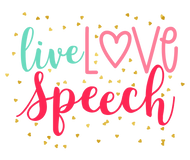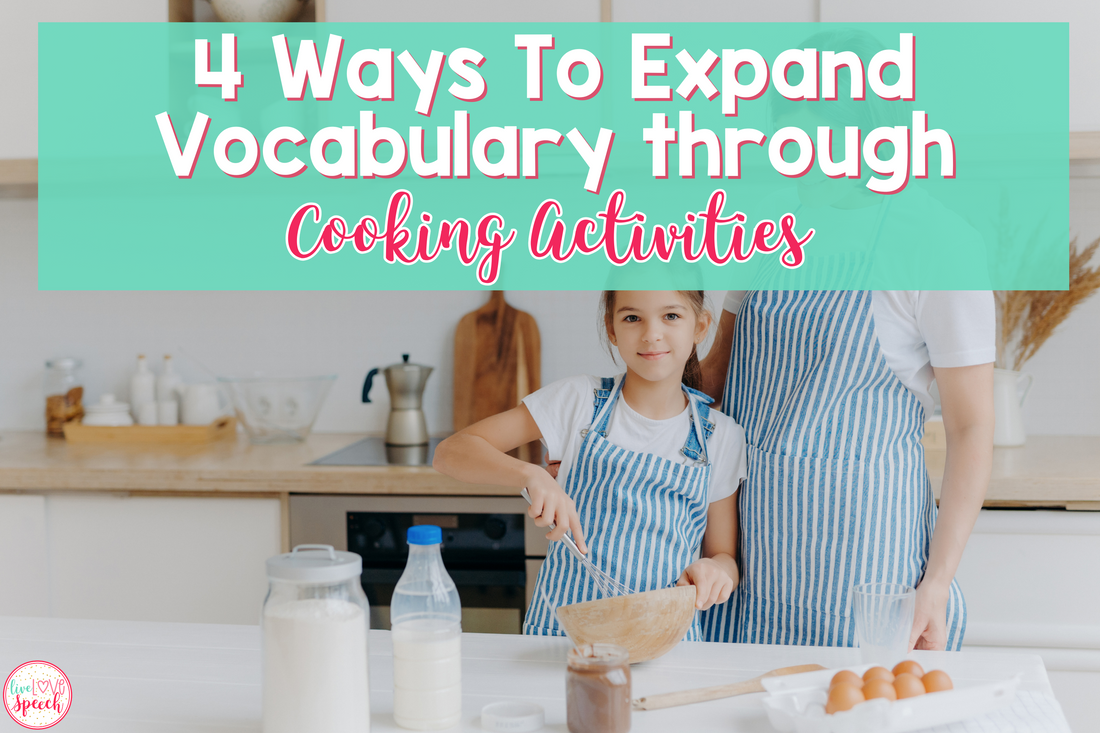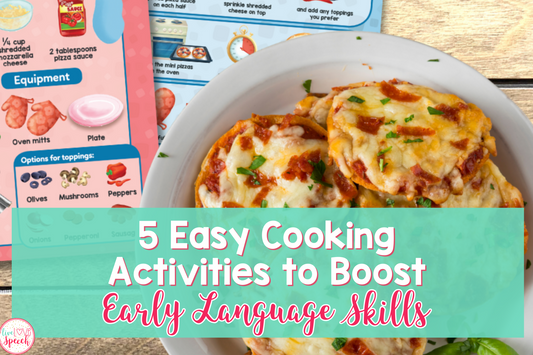
Teaching vocabulary is such an essential part of speech and language, but it often follows the same routine. We introduce, define, and use words in sentences, maybe repeat a few times. This method works well for some students, but sometimes, it can feel a bit monotonous and difficult to retain over the long term.
So, why not mix it up? As a speech pathologist and a mom, I’m always on the lookout for practical, memorable ways to help kids expand their vocabulary. My son, Landon, loves helping me in the kitchen, and I’ve seen firsthand how cooking activities can spark curiosity and build language skills. Cooking introduces vocabulary naturally, bringing words to life through the sights, sounds, and actions involved in preparing food.
With each step, students have opportunities to learn new words in a way that feels relevant and exciting. Here are four hands-on activities that are perfect for building vocabulary while cooking together. Let’s get started with some ideas you can use with your own students or kids!
Hands-On Activities to Teach Vocabulary
1. Introduce New Ingredients
Cooking is full of interesting ingredients with unique textures, colors, and flavors, which makes it perfect for introducing new vocabulary. Start by naming each ingredient and encouraging the child to repeat it. Then, talk about its characteristics to make the word stick.
To make the vocabulary-building activity even more engaging, introduce Ocean/Beach-Themed Visual Recipes! These come with a vocabulary list and ingredient list in a visual format that students can use directly in the activity. Each recipe includes a variety of supportive tools to enhance the learning experience, such as:
→ Comprehension Questions for each recipe, with visual supports
→ Vocabulary cards tailored to the recipe
→ A To-Do List to help plan and prepare each session
→ A Preference Sheet for caregivers to fill out, so you can learn more about the student’s tastes and needs
→ Print-and-go Shopping Lists (covering all the ingredients and tools)
→ Cheat Sheets with step-by-step instructions for each recipe
For example: with Under the Sea Pudding Cups, you can introduce ingredients like vanilla pudding, blue food coloring, and gummy fish. Start by naming each ingredient and encouraging the child to repeat it. As you mix the ingredients, ask questions like, “What color is the pudding? Is it smooth or lumpy?” This encourages the child to think about the texture and appearance of the ingredients.
With Tropical Fish Cookies, you can use sugar cookies, icing, and candy decorations. While decorating, discuss the different colors and shapes of the candies. Ask, “What do you think this candy feels like? Is it hard or soft?” Engaging the child with sensory questions builds descriptive vocabulary.
As you work through the recipe cards, encourage the child to describe what they see and feel. For example, with the visual recipe cards, you can incorporate sensory vocabulary by asking questions like, “How does the icing smell? Is it sweet or creamy?” This sensory exploration can help deepen their understanding and connection to the words.
Tip: Make vocabulary building delicious by creating a “recipe collection”! Each time you introduce a new recipe, like Under the Sea Pudding Cups or Tropical Fish Cookies, have the kids write down the names of new ingredients they encounter.
They can even illustrate their favorite part of the recipe, creating a fun visual reminder of the vocabulary they’ve learned. This way, they not only expand their vocabulary but also have a tasty collection to refer back to!
2. Name Cooking Tools
Introducing cooking tools by name is another great way to expand vocabulary in the kitchen. Each time you use a tool, introduce it by name and explain its purpose. Then, keep referring to the tool by name throughout the activity, so kids get repeated exposure.
You can also do this with visual recipes! Each step can show the tool along with its name, reinforcing understanding. For example, in a visual recipe, the image of a whisk helps children connect the word ‘whisk’ with its function. These visuals can really help vocabulary stick.
Example: “This is a whisk. We use it to mix things together and add air to the batter. Can you say ‘whisk’? Now, let’s try whisking the ingredients!”
To reinforce the names of these tools, you can ask questions like, “Can you pass me the spatula?” or “Which one is the whisk?” Giving them the chance to hear and say the names over and over strengthens word recall.
Tip: Create a “tool station” where kids can pick up each tool and name it before using it in the recipe. Repetition is key, so keep the names of these tools active throughout the cooking process.
3. Focus on Action Words
When cooking, it’s a great opportunity to emphasize action words that describe what we’re doing in the kitchen. With the Turkey Cookies visual recipe, you can focus on verbs like spread, mix, and decorate while preparing the cookies.

Example: “We’re going to spread the icing on our cookie. Spread means to evenly cover the surface. Can you say ‘spread’? Now, you try spreading the icing on your cookie!”
As you spread the icing, you can talk about decorating the cookies with candy corn to create colorful turkey feathers. Explain, “Now, let’s add the candy corn! We’ll use them to make the feathers on our turkey. Can you help me arrange them? How many candy corn will we use for each feather?”
Encouraging the child to repeat the action words as they perform each task reinforces their understanding of the terms while they also get to enjoy a delicious treat.
Tip: Create a fun game where the child has to demonstrate the action word. For instance, ask them to show you how to mix or spread while saying the word aloud. This kinesthetic approach makes learning more engaging and memorable!
To use this Visual Recipe for Free, click the image!
4. Describe What You See
Descriptive language is a vital part of vocabulary building, and cooking offers lots of sensory input for this. As you work through the Turkey Cookies visual recipe, ask the child to describe what they see, smell, or taste at each step.
Example: “What does the Oreo cookie feel like? Is it smooth or bumpy? What color are the candy corn? How does the icing smell?” Encourage them to explore the textures and aromas associated with each ingredient. For instance, you might say, “Let’s take a moment to feel the Oreo cookie. Is it crunchy or soft? And what about the candy corn? What colors do you see?”
Guide them with prompts to use adjectives and more complex vocabulary. This practice helps kids develop language skills beyond simple labeling, encouraging them to think more deeply about what they experience as they follow along with the visual recipes.
Tip: Encourage them to use full sentences. For example, prompt them to say, “The Oreo cookie is dark and crunchy,” or “The candy corn is bright orange and sweet.” For added fun, create a “chef’s tasting journal” where they can write or draw what they see, smell, and taste each time they cook. This activity reinforces descriptive language and gives them a fun record of their learning, which can also be complemented by the visual recipe cards that serve as a guide.
Extended learning
These activities not only expand vocabulary but also make learning interactive and memorable. Kids will get hands-on experience that reinforces new words, helping them understand, remember, and use language in meaningful ways.
For even more fun, you can use my play-based visual recipes, which involve cooking with pretend food! For example, you can engage children in a pizza-themed activity. This includes:
- Play-Based Therapy Information & Tips for Communication
- Visual Recipe with Step-by-Step Directions
- Comprehension Questions with Visual Answer Choices
- Vocabulary Cards
- Play-Based Therapy Cheat Sheet
- Interactive Toy Pieces (color and black & white)
- Visuals for Toys Booklet: Cover Card, 20 Vocabulary Words, 20 Verbs, 20 Basic Concepts, 10 Adjectives, 10 Colors, 10 Numbers & 10 Shapes
- 1 Page Sheet of Core Words & Phrases
- Parent/Guardian Letter
- Cut & Paste Sequencing Activity (Color & B/W)
- Toy, Game & Book Recommendations (Pizza Theme)
To learn more about my Play-Based Visual Recipes click here!
So, grab an apron and start cooking up some language skills, whether with real ingredients or play-based pizza! Grab your Visual Recipes here!
SAVE THIS POST
Don't forget to save this post on your favorite Pinterest board so you'll be all set when it comes time to plan your next Vocabulary activity!







